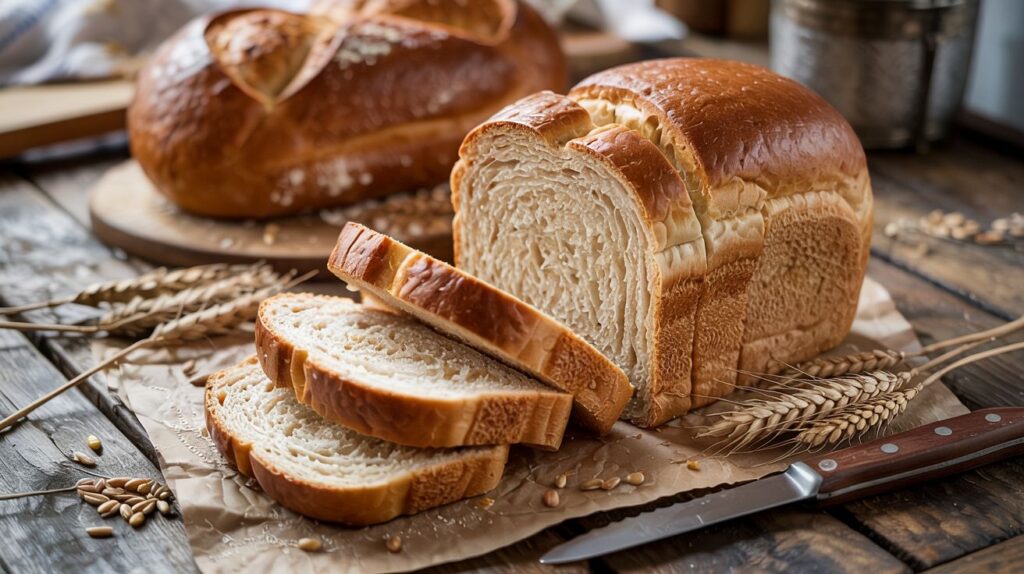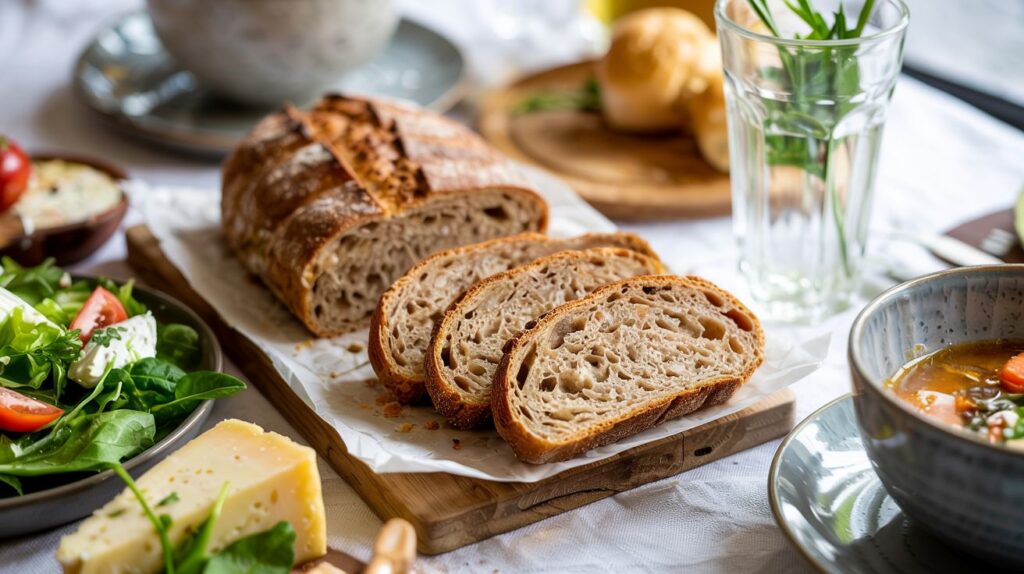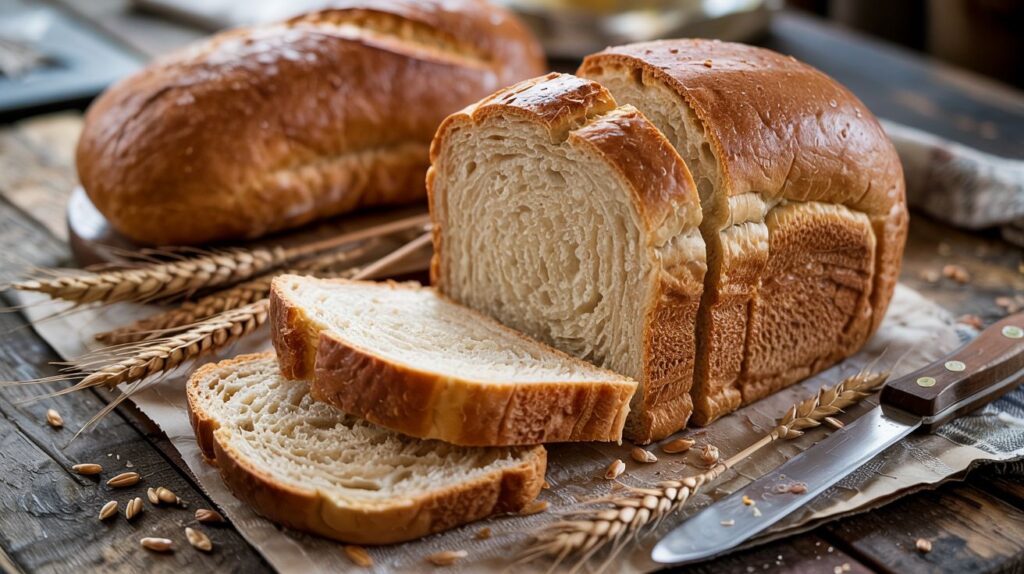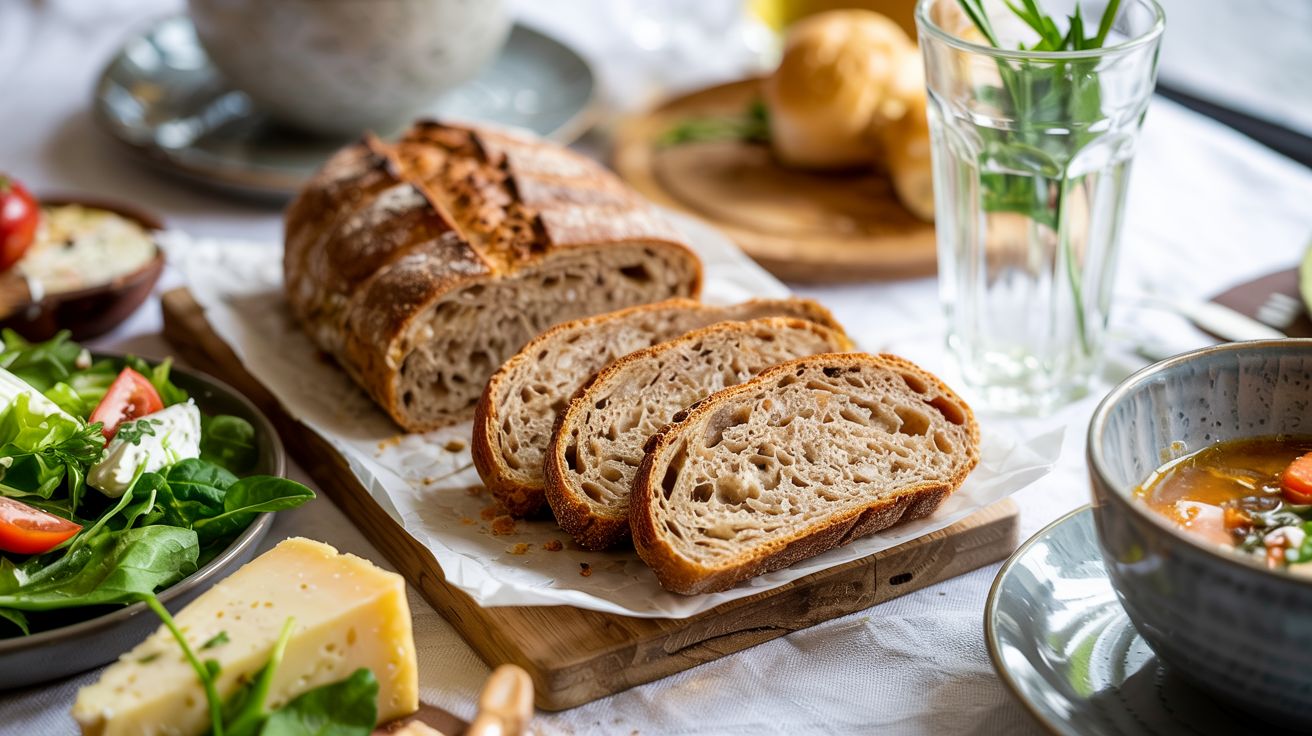Table of Contents
Whole Wheat Bread Flour for the Softest Loaves You’ll Love

Are you ready to bake the softest, most delicious loaves of bread you’ve ever tasted? Using whole wheat bread flour isn’t just about making healthier choices—it’s about bringing out rich, nutty flavors while keeping your bread light, fluffy, and full of nutrients. Imagine pulling a warm, homemade loaf out of the oven, the scent filling your kitchen as it promises a heartier, more satisfying bite. Whether you’re making sandwiches, enjoying it with a spread, or simply savoring a slice with a warm cup of tea, this whole wheat bread flour recipe will soon become a staple in your baking routine. Let’s dive in and see how easy it is to create this wholesome, fiber-rich bread from scratch!
Key Benefits of Whole Wheat Bread Flour
Whole wheat bread flour is a game-changer when it comes to baking nutritious, flavorful bread. Not only does it offer a richer taste, but it also packs a punch when it comes to health benefits. Here’s why it should be your go-to choice:
1. Rich in Fiber
Whole wheat bread flour is made from the entire wheat kernel, which means it retains the bran, germ, and endosperm. This gives your bread a significant boost in fiber content, making it a perfect choice for digestive health. The extra fiber helps keep you feeling full longer, which is great for weight management.
2. Packed with Nutrients
Unlike refined flour, whole wheat flour is full of essential nutrients like vitamins B1, B3, and B5, magnesium, and iron. These nutrients are vital for energy production, boosting your immune system, and maintaining healthy skin.
3. Low Glycemic Index
Whole wheat bread flour has a lower glycemic index (GI) compared to white bread flour. This means your blood sugar levels won’t spike as quickly after eating, helping you maintain steady energy throughout the day. It’s especially beneficial for those who are looking to manage their blood sugar levels.
4. Better for Heart Health
Whole wheat flour is known for its heart-healthy properties. The fiber and antioxidants in the flour help lower bad cholesterol levels and reduce the risk of cardiovascular disease. It’s an easy way to make your bread both delicious and heart-healthy.
5. Adds a Nutty Flavor
The whole wheat flour’s nutty, slightly sweet flavor adds depth to your homemade loaves. It transforms simple bread into something far more satisfying, with a richer taste that complements both sweet and savory toppings.
6. Perfect for Soft, Fluffy Loaves
Despite its health benefits, whole wheat flour can still create soft, tender loaves. With the right technique, you’ll get a bread that has a soft crumb, a slight chewiness, and a golden crust, perfect for sandwiches or just enjoying fresh from the oven.
Whether you’re baking for the family or preparing your daily bread, whole wheat bread flour not only makes for healthier loaves but also enhances your overall baking experience. It’s a simple swap that brings big rewards in flavor, texture, and nutrition!
Ingredients for Whole Wheat Bread Flour

Creating the softest, most delicious loaf starts with the right ingredients. Fortunately, the list is simple, and each item plays a vital role in achieving the perfect texture and flavor for your homemade bread. Here’s what you’ll need:
Essential Ingredients:
- Whole Wheat Bread Flour: The star of the show! This flour gives your bread that hearty, nutty flavor and rich texture.
- Active Dry Yeast: This helps your dough rise, ensuring your bread has that soft, fluffy crumb.
- Warm Water: This activates the yeast, setting the stage for the dough to rise. The water should be warm, but not too hot (around 110°F or 45°C).
- Olive Oil: Adds richness and helps create a soft, moist crumb.
- Honey: A touch of sweetness that complements the whole wheat flour and adds a subtle depth of flavor.
- Salt: Essential for flavor balance and controlling the yeast activity. Don’t skip it!
Optional Ingredients:
- Milk: For a slightly richer, softer bread. You can substitute it with water if you prefer a dairy-free version.
- Sugar: If you’d like a touch more sweetness, a little sugar can be added alongside the honey.
- Vital Wheat Gluten: If your bread needs a little extra structure or rise, a teaspoon of gluten can be mixed in. It’s especially useful if you’re working with a high percentage of whole wheat flour.
These simple ingredients come together to create a nourishing, flavorful loaf. Make sure to use the freshest yeast for the best results. And don’t be afraid to get creative—adding seeds like sunflower or flax can give your bread a fun twist, both in flavor and texture!
Once you have everything ready, you’re set to dive into the next step: making this wholesome bread come to life in your kitchen. Let’s move on to the magic of the mixing and rising process!
How to Make Whole Wheat Bread Flour at Home
Making your own whole wheat bread flour at home is surprisingly simple, and it allows you to enjoy the freshest, most nutritious flour for your bread. If you have a grain mill or a high-powered food processor, you can grind your own whole wheat flour from wheat berries. Here’s how to do it:
What You’ll Need:
- Wheat Berries: You can use hard red wheat berries, which are the most common for bread-making, or soft wheat berries for a lighter texture.
- Grain Mill or Food Processor: A grain mill is ideal, but a food processor can also work if you don’t have one.
- Sifter (Optional): If you prefer a finer flour, you can sift the ground flour to remove larger pieces.
Steps to Grind Whole Wheat Flour:
- Prepare the Wheat Berries: Start by measuring out the amount of wheat berries you need for your recipe. One cup of wheat berries will yield about 1 ½ cups of whole wheat flour, so plan accordingly.
- Grind the Wheat Berries:
- If using a grain mill, simply follow the manufacturer’s instructions for grinding the berries into flour. Most mills allow you to adjust the coarseness of the grind. For bread flour, aim for a fine to medium grind.
- If using a food processor, place the wheat berries in the processor and pulse until they’re finely ground. This will take a few minutes. Be sure to pause and stir the flour occasionally to ensure even grinding.
- Sift the Flour (Optional): After grinding, you can sift the flour if you prefer a finer texture. This will remove larger bran pieces that can make the flour a bit coarser. However, if you want to keep all the nutritious bran in your flour, you can skip this step.
- Store the Flour: Freshly ground whole wheat flour doesn’t have preservatives, so it’s best to use it right away for the best flavor and texture. If you have leftovers, store the flour in an airtight container in the fridge or freezer to preserve its freshness.
Why Grind Your Own Flour?
- Freshness: Grinding your own flour means you’re using the freshest flour possible, which adds more flavor and nutrition to your bread.
- Control: You have complete control over the texture of your flour. Want a coarser texture for rustic bread? Or a finer flour for smoother loaves? You decide.
- Nutrient Retention: When flour is ground and stored commercially, it can lose some of its nutrients over time. Freshly ground flour retains more of its natural vitamins and minerals, making your bread even more nutritious.
By grinding your own whole wheat flour, you’ll elevate your bread-baking experience to a whole new level, bringing a delightful, nutty richness to your homemade loaves. Now that you’ve got your flour ready, it’s time to move on to the next step—mixing the dough!
Pro Tips and Variations
To ensure your whole wheat bread turns out perfectly every time, there are a few pro tips and variations that can help elevate your baking skills. Whether you’re aiming for a soft, fluffy loaf or want to experiment with different textures, these tips will make your bread-baking experience even more rewarding.
Pro Tips for the Best Whole Wheat Bread:
- Use Warm Water, Not Hot: When activating the yeast, make sure the water is warm (around 110°F or 45°C). If it’s too hot, it can kill the yeast; too cold, and it won’t activate properly. Warm water is the sweet spot for yeast growth, ensuring your bread rises to perfection.
- Let the Dough Rest: Don’t rush the rising process! After mixing your dough, let it rest and rise in a warm, draft-free place. The first rise should take about 1 to 1 ½ hours, until the dough has doubled in size. This resting period is essential for developing flavor and texture.
- Knead the Dough Gently: Kneading your dough helps develop the gluten, giving your bread structure. However, be careful not to overdo it. Knead just enough until the dough is smooth and elastic. If you’re using whole wheat flour, you may notice the dough feels a little denser, but it should still come together beautifully.
- Shape the Loaf Properly: When shaping the dough for your loaf, make sure it’s tightly rolled. This helps create a smooth, even texture throughout the bread. If you’re using a loaf pan, be sure to grease it lightly or line it with parchment paper for easy removal.
- Score the Bread: Scoring your bread (making shallow cuts on top) not only makes it look more appealing but also helps it bake evenly. The cuts allow the bread to expand as it rises in the oven, giving it that classic rustic look.
Variations to Try:
- Add Seeds for Extra Crunch: To add flavor and texture, incorporate sunflower seeds, flax seeds, or sesame seeds into your dough. You can mix them into the dough itself or sprinkle them on top before baking for a beautiful, crunchy crust.
- Substitute Olive Oil with Butter: If you prefer a richer, slightly sweeter flavor, swap the olive oil with melted butter. It will create a softer, more tender crumb, perfect for those who love a buttery texture.
- Add a Touch of Sweetness: If you like your bread slightly sweeter, try adding a tablespoon of brown sugar or maple syrup in place of the honey. This will give your loaf a deliciously warm sweetness, great for breakfast or as a snack.
- Mix in Whole Grains or Oats: For even more texture and nutrition, you can add oats or whole grain flour alongside your whole wheat flour. This variation adds a hearty, satisfying bite to your bread, making it even more filling and nourishing.
- Experiment with Herbs: For a savory twist, mix in fresh herbs like rosemary or thyme. The aroma while baking will be irresistible, and the herbed bread will pair wonderfully with soups or salads.
By following these tips and experimenting with variations, you can customize your whole wheat bread to your exact tastes. Whether you’re baking for a family dinner or just craving some homemade comfort, these simple adjustments will help you create the perfect loaf every time. Now, let’s move on to serving suggestions to make your freshly baked bread even more enjoyable!
Serving Suggestions

Now that you’ve baked your delicious, soft whole wheat bread, it’s time to enjoy it! The possibilities are endless when it comes to how you can serve your freshly baked loaf. Here are some tasty serving suggestions to help you make the most of your bread:
1. Classic Sandwiches:
Whole wheat bread is perfect for making hearty, healthy sandwiches. The rich, nutty flavor complements a variety of fillings. Try it with:
- Avocado and turkey for a wholesome lunch.
- Peanut butter and banana for a simple, satisfying snack.
- Classic BLT for a crowd-pleasing choice that works for any occasion.
2. Toasted for Breakfast:
There’s nothing like a warm slice of toast to start your day. Slice your whole wheat bread and toast it to golden perfection. Top with:
- Butter and jam for a comforting breakfast.
- Nut butter (almond, cashew, or peanut) for a protein-packed spread.
- Soft-boiled eggs for a complete, filling meal.
3. Pair with Soups and Salads:
Whole wheat bread makes a fantastic side to soups and salads, adding a hearty texture and flavor to your meal. Serve alongside:
- Tomato soup for the ultimate classic combo.
- A fresh green salad with balsamic vinaigrette for a light, healthy meal.
- Chili or stews for a warming, satisfying dinner.
4. Make Croutons or Bread Crumbs:
Don’t let any leftover bread go to waste! Cut your whole wheat bread into cubes, toss with olive oil, and toast them in the oven to make your own homemade croutons. Use them to top:
- Caesar salad for extra crunch.
- Soup for a delightful texture contrast. Alternatively, grind your bread into crumbs to use as a coating for baked chicken or fish, or mix it into meatballs or meatloaf for added flavor.
5. Serve with Cheese and Charcuterie:
For a simple, elegant appetizer or snack, pair your whole wheat bread with an assortment of cheeses and cured meats. The earthy flavor of the bread is an excellent match for:
- Cheddar, brie, or goat cheese.
- Salami, prosciutto, or smoked ham. Add some fresh fruits, olives, and nuts to make the spread even more delicious.
6. Make French Toast:
Transform your whole wheat bread into a decadent breakfast treat by making French toast. Dip the slices in an egg-milk mixture, fry until golden, and serve with:
- Maple syrup and a dusting of powdered sugar.
- Fresh berries and whipped cream for a festive touch.
With so many ways to enjoy your homemade whole wheat bread, you’ll never run out of ideas. It’s not just bread—it’s the perfect base for creating countless delicious dishes, from savory meals to sweet treats. So, slice away and start enjoying your wholesome, heartwarming bread today!
Conclusion
Making whole wheat bread at home is not just about creating a loaf of bread—it’s about embracing the process, enjoying the aroma of freshly baked bread, and savoring the satisfaction of knowing exactly what goes into your food. By using whole wheat bread flour, you’re bringing a healthy, flavorful option to your table that’s perfect for any occasion.
Whether you’re new to baking or an experienced home baker, this recipe provides a simple, approachable way to make delicious whole wheat bread that’s both soft and hearty. The tips and variations we’ve covered give you the flexibility to experiment and customize your bread to suit your tastes.
Remember, the key to great bread is patience. Allowing the dough to rise properly and taking your time with each step ensures you’ll have a perfectly baked loaf. Plus, once you’ve got the hang of it, you can enjoy the endless possibilities for using your bread in sandwiches, toasted snacks, or alongside soups and salads.
So, roll up your sleeves and start baking! Whether you’re making a batch for your family or sharing with friends, homemade whole wheat bread is sure to become a favorite in your kitchen. Enjoy the process, the flavors, and the warmth it brings to your home.
Happy baking, and don’t forget to share your beautiful creations with us!

FAQs
To help you get the most out of your whole wheat bread-baking experience, here are some frequently asked questions. Whether you’re a beginner or an experienced baker, these answers will provide you with practical tips and troubleshooting advice.
1. Can I use all-purpose flour instead of whole wheat flour?
Yes, you can substitute all-purpose flour for whole wheat flour, but keep in mind that your bread will have a lighter texture and less of the rich, nutty flavor associated with whole wheat bread. If you prefer a softer loaf, you can even use a combination of whole wheat and all-purpose flour.
2. Why did my dough not rise properly?
There are a few reasons why your dough might not rise:
- Inactive yeast: Make sure the yeast is fresh and activated in warm water (not too hot or cold).
- Cold environment: Yeast works best in a warm, draft-free place. Try placing the dough in an oven with the light on or covering it with a damp towel in a warm area.
- Over-kneading or under-kneading: Both can affect the dough’s ability to rise. Make sure to knead until smooth and elastic, but not too long.
3. How can I make my whole wheat bread softer?
Whole wheat flour tends to make bread denser, but there are ways to achieve a softer loaf:
- Add vital wheat gluten: This will help improve the texture and give the bread more elasticity.
- Use milk or butter: Incorporating dairy will make the bread softer and richer.
- Don’t overbake: Keep an eye on your bread to avoid over-baking, as this can make it dry and tough.
4. Can I store whole wheat bread at room temperature?
Yes, you can store your bread at room temperature for a few days. Place it in an airtight container or wrap it in a cloth to keep it fresh. For longer storage, slice the bread and freeze individual slices, so you can toast them directly from the freezer.
5. How can I make whole wheat bread more flavorful?
To enhance the flavor of your whole wheat bread:
- Add herbs: Fresh herbs like rosemary or thyme can infuse your bread with aromatic flavors.
- Sweeteners: A small amount of honey, maple syrup, or molasses can add sweetness and depth.
- Seasonings: Consider adding a pinch of sea salt, garlic powder, or even cheese to the dough for an extra flavor boost.
6. Can I make this recipe with a bread machine?
Absolutely! You can use a bread machine to mix, knead, and bake your whole wheat bread. Simply add the ingredients in the order recommended by your machine’s manual and set it to the whole wheat cycle for best results.
7. How do I know when my bread is done baking?
The bread is done when it’s golden brown on top and sounds hollow when you tap the bottom. You can also use a thermometer—bread is fully baked when the internal temperature reaches 190-200°F (88-93°C).
These answers should help guide you through any questions or challenges you might encounter while baking your whole wheat bread. Remember, bread-making is as much about practice as it is about following the recipe. Each loaf is a step toward mastering the craft! Happy baking!
Whole Wheat Bread Recipe Recap
Recipe Details:
- Prep Time: 15 minutes
- Cook Time: 30 minutes
- Total Time: 1 hour 45 minutes (including rise time)
- Servings: 12 slices
- Calories: 120 per slice (approximately)
Nutrition Information (per serving):
- Calories: 120 kcal
- Fat: 2.5g
- Carbohydrates: 20g
- Fiber: 3g
- Sugar: 3g
- Protein: 4g
- Sodium: 160mg
- Cholesterol: 0mg
Categorize the Recipe:
- Course: Bread, Snack, Breakfast
- Cuisine: American
- Diet: Vegetarian, Whole Grain
- Method: Baking
- Keyword: Whole Wheat Bread, Homemade Bread, Healthy Bread
- Skill Level: Beginner to Intermediate
This whole wheat bread is not only healthy but versatile and easy to make, offering a rich, hearty flavor and a soft texture that’s perfect for all occasions. Whether you’re serving it with a savory meal, turning it into a delicious sandwich, or toasting it for breakfast, this bread is a staple in any kitchen!

